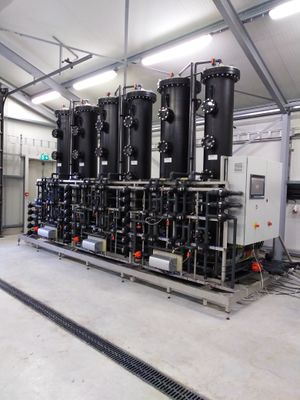LC 00472: verschil tussen versies
Geen bewerkingssamenvatting |
Geen bewerkingssamenvatting |
||
| Regel 1: | Regel 1: | ||
Lies | Lies researched ion exchange (IX) technology as a desalination treatment step after the wetlands with the aim to upgrade the water quality to industrial or agricultural standards. | ||
''To provide a sustainable source of fresh water for the industry in Zeeuws Vlaanderen the reuse of effluents streams is researched in a Joint Development Project with Evides Industriewater and Dow Terneuzen. Effluent from the wastewater treatment plant of the municipality Terneuzen and industrial effluent from Dow is treated with constructed wetlands followed by a brackish waterline. This brackish waterline exists of ultrafiltration, ion exchange and reverse osmosis, and is researched for its potential to produce demi water.'' | ''To provide a sustainable source of fresh water for the industry in Zeeuws Vlaanderen the reuse of effluents streams is researched in a Joint Development Project with Evides Industriewater and Dow Terneuzen. Effluent from the wastewater treatment plant of the municipality Terneuzen and industrial effluent from Dow is treated with constructed wetlands followed by a brackish waterline. This brackish waterline exists of ultrafiltration, ion exchange and reverse osmosis, and is researched for its potential to produce demi water.'' | ||
| Regel 10: | Regel 10: | ||
[[Bestand:IX-2 pilot.jpg|miniatuur]] | [[Bestand:IX-2 pilot.jpg|miniatuur]] | ||
{{External link|resource=Resource Hyperlink 00785|name=TKI deltatechnolgie Wetlands als voorzuivering voor ontzilting|dialog=process-linkwebsite-dialog}} | {{External link|resource=Resource Hyperlink 00785|name=TKI deltatechnolgie Wetlands als voorzuivering voor ontzilting|dialog=process-linkwebsite-dialog}} | ||
{{Light Context | {{Light Context | ||
|Supercontext=PR 00322 | |Supercontext=PR 00322 | ||
Huidige versie van 2 jun 2021 om 10:52
Lies researched ion exchange (IX) technology as a desalination treatment step after the wetlands with the aim to upgrade the water quality to industrial or agricultural standards.
To provide a sustainable source of fresh water for the industry in Zeeuws Vlaanderen the reuse of effluents streams is researched in a Joint Development Project with Evides Industriewater and Dow Terneuzen. Effluent from the wastewater treatment plant of the municipality Terneuzen and industrial effluent from Dow is treated with constructed wetlands followed by a brackish waterline. This brackish waterline exists of ultrafiltration, ion exchange and reverse osmosis, and is researched for its potential to produce demi water.
An ion exchange unit is used to research the removal of specific anions and cations to desalinate the water and to reduce biofouling and scaling on the reverse osmosis membranes. Ion exchange resins, as the name says, exchange ions during the production, until they are exhausted. Then the resins need to be regenerated to make them functional again. Therefore, chemicals are used, mainly HCl, NaOH and NaCl. Several experiments have been performed on lab and pilot scale to find the most efficient regeneration settings for different resins. To reduce the amount of chemical use for the regeneration, a model will be built to predict the needed amount of chemicals.
The model gives the most effective regeneration parameters to reach a certain operating capacity. The parameters considered are concentration of the chemical, flow rate of injecting the chemical and the contact time of the chemical with the resin. The model is based on data from different experiments. First, it will be checked whether data from the same resins on the different scales are comparable and reliable. Then, functions will be made based on the data, which will be used to build the model.
In the end, a model for three different resins is expected which is based on data from both lab and pilot scale and can be applied on full scale. The model gives the regeneration settings with the lowest chemical use to reach a certain operating capacity. With this model, the regeneration can be optimized and the chemical use will be more effective.
TKI deltatechnolgie Wetlands als voorzuivering voor ontzilting

